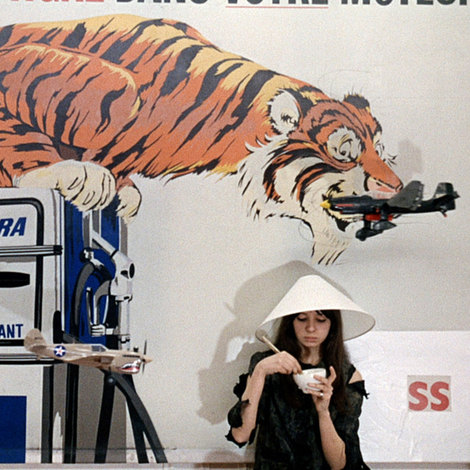What happens when Gen Z–ers, hopped up on TikTok videos, come for their favorite young fogey?
“It’s a bit like locusts,” Sean Crowley says one afternoon on the third floor of the reconstituted Dumbo, Brooklyn, warehouse that is home to Crowley Vintage, which many fans of traditional Anglo-American men’s clothing consider to be the greatest source for secondhand between London and Tokyo.
“It took me an hour to make sense of the mess of all the sweaters here,” he says, nodding to a treaty table piled 10-high with an array of cream, cable-knit tennis sweaters—something the Duke of Windsor might have worn, or Björn Borg at Wimbledon.
“But thanks to them,” Crowley continues, “I had my second-best Saturday ever. It’s just a bit crazy, though. I never could never have created this kind of interest in what I do if I tried.”

For all its nearly seven years in existence, Crowley Vintage has been a semi-well-kept secret among style-gods as disparate as the movie director Paul Feig and the rapper Tyler, the Creator, all of them united by their love of traditional—or what Gen Z calls “trad”—clothing. (Tyler the Creator was reportedly so worried about the store being discovered that he recently called out a friend for posting about it on social media.)
In short, Crowley Vintage is a place style obsessives are obsessive about—where they know they can find a 1970s Brooks Brothers camel-hair stadium coat; a 1980s double-breasted, navy chalk-stripe suit from Anderson & Sheppard; or just about anything else that epitomizes WASP style in the 20th century.
However, that semi-secretness was blown to bits by a recent flurry of TikTok videos in which several twentysomethings “reported” from the store, with that breathless perspective that seems particular to Gen Z when they encounter something new: a wide-eyed, can-you-believe-it tone. As in, “What if I told you that I discovered … a man … in Brooklyn … who has a secret stash of amazing old clothes … that make you look like you could be on The Crown!”

Cue the locusts.
The breadth, depth, and quality of Crowley’s offerings are such that designers who work for Ralph Lauren and the streetwear brand Aimé Leon Dore are known to make trips there in search of vintage pieces to acquire for the company’s archives, or that might serve as inspiration for new collections.
It’s no surprise to learn then, that when Ralph Lauren (the man himself) met Crowley, it was a game-recognize-game moment, and he invited Crowley to design for him on the spot.
But we’re getting ahead of ourselves.
Crowley, who is 42 years old and looks like a younger, trimmer, more handsome Brendan Gleeson, says he never thought he would make vintage men’s wear his life, but in retrospect it seemed inevitable. He grew up in Massachusetts, land of the Brimfield Antique Flea Market, which connoisseurs argue is the oldest and biggest of its kind in America. Crowley’s grandfather was a clothing designer and Crowley’s father liked to scour the local flea markets every Sunday, his son in tow.

“That was our church,” Crowley says. He says, too, that he “learned to love the hunt,” helping his father find pieces on his list. “I loved the stories, hearing the old-timers tell you not just what the thing was, but the story behind it.”
Crowley says that by eighth grade he knew he liked the Anglo-American aesthetic, but he didn’t know that was what you called it, let alone that he could do anything with his interest.
Then came those two great charmers who have changed the perspectives of innumerable young men: Jeeves and Wooster. Crowley never forgot when they entered his life.
“As a boy, I would watch Masterpiece Theatre with my grandfather, and he showed me ‘Jeeves and Wooster’—this was the version with Stephen Fry and Hugh Laurie—and it was a light-bulb moment. The two of them were charming and funny, and they looked fantastic … they were wearing the clothes I loved. Suddenly, everything took shape for me. I could see a world I wanted to live in.”

By the time Crowley was in college, he was working for Bobby Garnett, the proprietor of Bobby from Boston, the influential Lynn, Massachusetts, vintage store that’s sort of a spiritual predecessor to Crowley’s own shop. He met Garnett as a 14-year-old when they were eyeing the same shirt at a flea market.
“As a boy, I would watch Masterpiece Theatre with my grandfather, and he showed me ‘Jeeves and Wooster.’ … Suddenly, everything took shape for me. I could see a world I wanted to live in.”
“I had just started my men’s-wear journey, you might say. I had all the interest and none of the knowledge, and Bobby changed all that. He took me on my first buying trip to London. My store would not exist without him. He taught me everything that was cool.”
After college, Crowley got a job at the Ralph Lauren mansion in New York City through Ralph Lauren designers who frequented Bobby’s shop. One day in 2005, the man himself stopped by and noticed Crowley’s style.

“The next thing I knew, he asked me to come to work in the design department.”
Crowley designed ties at first, and then tailored clothing, but left the company in 2015 to start selling goods off a single rolling rack in his apartment. He estimates that he now has more than 10,000 pieces.
“All the inventory is in my head,” he says, as he sweeps his arm toward the shop, where there is a section—or in some cases, several—for everything: suits, sport coats, dress shirts, topcoats, shoes, ties, and more. His vision from the beginning was to create “a true retail experience,” meaning that everything is organized. Meaning, too, that this is not a place that smells of mildew and mustiness, where you are forced to pick through sad piles of pilled sweaters and moth-chewed flannels. No, Crowley personally inspects every garment that comes in and only sells it if he would wear it himself.
The store is merchandised with the same eye and attention to detail that one finds in the Ralph Lauren mansion—and a similar horror vacui, too. Wherever there isn’t a stack of shirts or a rack of suits, there are vintage Pendleton camp blankets, wicker fishing creels, ashtrays from long-extinct social clubs, well-worn Barbour jackets, prep-school pennants, and even a bearskin hat of the kind worn by the King’s Guard. And everything is for sale. It’s not uncommon that a customer will spend $5,000 at a pop.

Crowley also has a large female clientele. “They love men’s clothes, the cuts and the fabrics. They’re also a more decisive shopper. I like that. Men, if you want to know, can be wishy-washy.”
The Gen Z shoppers are decisive, but they have a different problem. “It’s all champagne taste for too many of them,” Crowley says. “Thanks to social, they know a lot about what they want and how they want to look. What they don’t seem to know is that it costs money… Still, they’re good customers, and it’s great to see a new generation coming in.”
Crowley thinks a lot about those days spent wandering flea markets with his father, and how that time spent handling goods and listening to the sellers—all of it done in person, without the Internet—educated his eye. He worries that’s lost on a generation that sees everything on their phones, but rarely I.R.L. “‘Field work,’ we used to call what we did,” he says with a laugh. “Is anyone teaching that anymore?”

We’re standing in the back of the shop, where there are boxes of goods that have just come in. Hanging on a peg behind him is a blue blazer with red, zigzag trim on the lapels. He tells me it is from the 1870s and was created for the Royal Artillery—thus the distinguishing trim. Crowley raises the jacket and its hanger off the peg and admires it.
“I can’t believe I was able to save this,” he says, as much to himself as to me.
I ask him if there is a rosebud piece out there, something he longs to have, or maybe something he lost.
“Not a garment,” he says. “But I also collect Wedgwood, and I once had the chance to buy a pattern from the 1870s, and I said I’d think about it. When I came back, it was sold. I wish more people understood that about vintage. Buy it when you see it. You won’t get a second chance.”
Michael Hainey is a Writer at Large at AIR MAIL and a co-host of its Morning Meeting podcast


